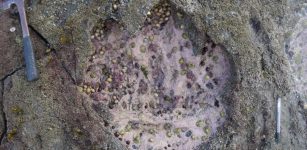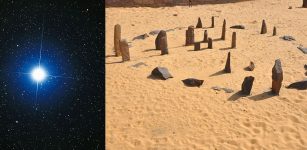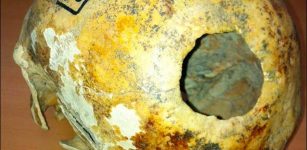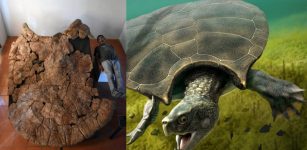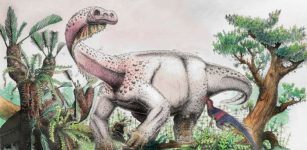Giant Human-Sized Penguins Ruled The World After Dinosaurs Died Out
Eddie Gonzales Jr. – MessageToEagle.com –About 60 million years ago, after the dinosaurs were wiped out on sea and land, giant human-sized penguins ruled the world.
Fossil records show very large penguins flew through Southern Hemisphere waters, alongside smaller forms, similar in size to some species that live in Antarctica today.
Now the newly described Kupoupou stilwelli has been found on the geographically remote Chatham Islands in the southern Pacific near New Zealand’s South Island. It appears to be the oldest penguin known with proportions close to its modern relatives.
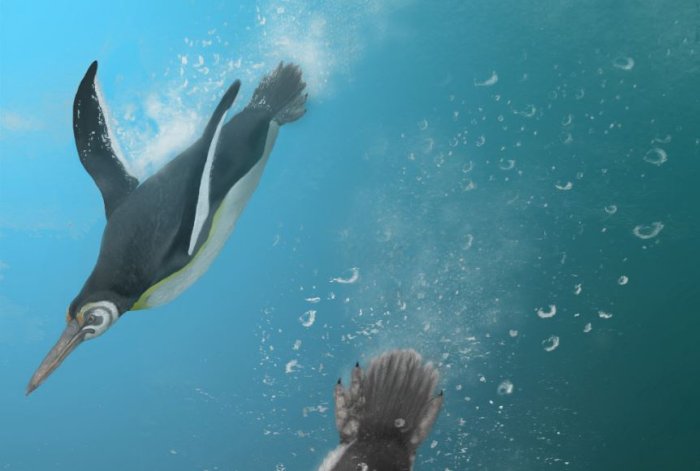
An artist’s impression of Kupoupou stilwelli by Jacob Blokland, Flinders University
It lived between 62.5 million and 60 million years ago at a time when there was no ice cap at the South Pole and the seas around New Zealand were tropical or subtropical.
“Next to its colossal human-sized cousins, including the recently described monster penguin Crossvallia waiparensis, Kupoupou was comparatively small — no bigger than modern King Penguins which stand just under 1.1 metres tall,” Flinders University PhD palaeontology candidate and University of Canterbury graduate Jacob Blokland said.
“Kupoupou also had proportionally shorter legs than some other early fossil penguins. In this respect, it was more like the penguins of today, meaning it would have waddled on land.
“This penguin is the first that has modern proportions both in terms of its size and in its hind limb and foot bones (the tarsometatarsus) or foot shape.”
As published in the US journal Palaeontologica Electronica, the animal’s scientific name acknowledges the Indigenous Moriori people of the Chatham Island (Rēkohu), with Kupoupou meaning ‘diving bird’ in Te Re Moriori.
The discovery may even link the origins of penguins themselves to the eastern region of New Zealand — from the Chatham Island archipelago to the eastern coast of the South Island, where other most ancient penguin fossils have been found, 800km away.
See also:
Meet Quetzalcoatlus – World’s Largest Flying Animal Had A Wingspan Of Up To 52 Feet (15.9 m)
Goliath Birdeater: World’s Largest Spider Can Grow As Long As A Child’s Forearm
Monster Bird ‘Kumimanu’ Was A Giant Penguin That Reached Human Height
“We think it’s likely that the ancestors of penguins diverged from the lineage leading to their closest living relatives, such as albatross and petrels, during the Late Cretaceous period, and then many different species sprang up after the dinosaurs were wiped out,” University of Canterbury adjunct Professor Scofield, Senior Curator of Natural History at the Canterbury Museum in Christchurch explained.
“It’s not impossible that penguins lost the ability to fly and gained the ability to swim after the extinction event of 66 million years ago, implying the birds underwent huge changes in a very short time. If we ever find a penguin fossil from the Cretaceous period, we’ll know for sure.”
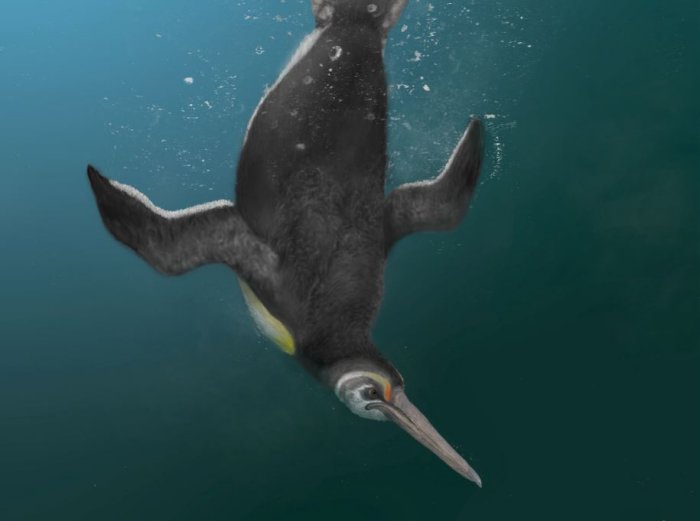
An artist’s impression of Kupoupou stilwelli by Jacob Blokland, Flinders University
The new species is based on the fossilized bones of five partial skeletons. Another two specimens showed a second larger penguin species was also present on the main Chatham Island but there was not enough material to formally name it.
All of the described skeletons were collected between 2006 and 2011 by a group led by Monash University palaeontologist Jeffrey Stilwell. Dr Alan Tennyson from Te Papa Tongarewa the Museum of New Zealand and Professor Julia Clark from University of Texas at Austin were in the group and are also-coauthors of the paper. The species is named after Associate Professor Stilwell with all specimens now cared for by Te Papa.
Written by Eddie Gonzales Jr. – MessageToEagle.com Staff
Expand for referencesJC Blokland, CM Reid, TH Worthy, AJD Tennyson, JA Clarke and RP Scofield. Chatham Island Paleocene fossils provide insight into the palaeobiology, evolution, and diversity of early. Palaeontologia Electronica, 2019 DOI: 10.26879/1009



